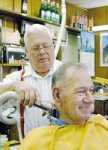A cut above the rest

CHARLESTON --
It's not too difficult to find Henry's Barber Shop off South Main Street in Charleston.
For starters, a 9-foot-tall barber pole greets Coffer's clients. And from there, visitors will encounter about five more barber poles throughout his shop --
not to mention wall-to-wall memorabilia and old-time furniture and accessories like the 30-year-old vacuum hose Coffer uses to clean up his clients once he's finished cutting their hair.
And don't try to make an appointment before you go --
Coffer doesn't accept them. Also, he only answers to Henry, not Mr. Coffer.
"I'd say I'm a dying breed," said the 73-year-old barber. "You know why? It's tougher to become a barber these days than it is a beautician."
Coffer attended Moler Barber College in St. Louis for six months and had to work at a barber shop for 18 months before he could get his license.
In 1956, he began barbering at Mack's Barber Shop in Sikeston. He moved to Charleston in 1957 and worked at McCormick's Barber Shop in downtown Charleston for several years. But for the past 33 years, he has worked out of the shop behind his house.
Jim Powell of Charleston said he's been going to Coffer since he was a little boy.
"The only difference is now I don't get a sucker," Powell laughed.
And Bill Forgey of Sikeston brought his grandson, Tyler Anderson, 9, to Coffer to get a haircut on Friday.
"Not too many shops have the view of a state-winning Dogwood tree, or one of the biggest barber poles around," Forgey pointed out.
At Coffer's shop, walls are clad in memorabilia such as several tobacco sacks; a framed, matted and signed picture of President Harry S. Truman; Wheaties cereal boxes with Larry Bird and more. Furniture consists of a 1940s couch, and Coffer uses a modern electric hydraulic chair he purchased from a salvage yard.
Lots of talking takes place in Coffer's shop, he admitted.
"I've got people coming here that say, 'Henry, I don't come here for the haircuts, I come here for the conversation' -- and the bull, if you want to know the truth about it," Coffer laughed.
Unlike some of the old-time barber shops, Coffer said visitors won't find any inappropriate periodicals.
"I don't keep Playboy or anything like that," Coffer said. "You won't find any of that here. Women and young kids come in and I'm not going to contaminate them."
Eric Brown, business administrator of SEMO Hairstyling Academy in Cape Girardeau, said at one time the barber profession may have been in trouble, but he thinks that trend is being reversed.
"Back in the day, when men started wearing long hair in the 1970s, barbers lost a lot of business," Brown explained. "All of the men that wanted to get their perms started going to cosmetologists to receive their services. Fortunately, they started wearing short hair again."
But according to the Missouri Division of Professional Registration, Coffer is one of 37 licensed barbers in Scott, New Madrid, Mississippi and Stoddard counties. In 1993 Missouri had 4,210 active licensed barbers, and today, the state has 3,293, a drop of 22 percent.
Meanwhile, the number of licensed cosmetologists is increasing.
The main difference between a barber and cosmetologist is the manicuring, pedicuring, makeup applications, etc. However, a cosmetologist cannot put a razor on a person's face --
only a licensed barber can, Brown explained.
"Barbers still practice the art of shaving," Brown said. "We don't get into makeup application. We do the hair cutting, styling, hair coloring and other chemical services."
Today the state requires students to learn those things, Brown said.
Brown received his license eight years ago, and in 2001, he opened the SEMO Hairstyling Academy, the only licensed barber school in the area. About six others are located in Kansas City, St. Louis or Springfield.
Since 2001 approximately 20 students have completed the six-month program and received their licenses.
"I feel that the profession was on its last leg, but there's been a great effort to revive it," Brown said. "Out on the East and West coasts, razor shaving is an elite thing done at spas for men. In the Midwest, it takes a little more time for trends to get here, but it's excelling again."
Licensed barber Shea Mouser graduated from SEMO Styling in August 2002. He's currently running Stace's Barber Shop in Sikeston, but prior to that, Mouser worked at a barber shop in Nashville, Tenn., for awhile.
"It was an old-style barber shop, and I learned a lot of from the barber I worked with," Mouser said. "And the old way is not so much of a bad thing."
While shaving isn't in much of a demand today, Mouser would like his shop to look old-style like traditional barbers like Coffer.
"The barber shop is the cornerstone in a community," Brown theorized. "It's where men go to bond, and do . . . men stuff," he paused and then a boom of laughter came tumbling out of his mouth.
And as for Coffer, he admitted he doesn't plan to retire anytime soon.
"As long as I'm able and people can tolerate the haircuts I put out, I'll be here," Coffer said. "And if I can't make you laugh or smile before you leave this shop, you never got your money's worth."

